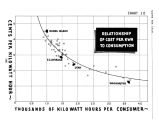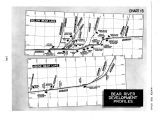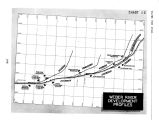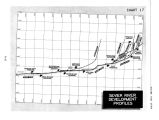| OCR Text |
Show WATER FOR UTAH other related materials for carbon electrode and carbon paste manufacture, might provide opportunity for a large- scale carbon electrode industry, if requisite power supplies can be made available at low cost. If that type of industry can be established in Utah, it might also be possible to include the production of graphite and graphi- tized products. A plant producing 100,000 tons of graphite products would require on the order of 200 to 300 million kilowatt- hours per year. OTHER HYDROCARBONS The geological processes which endowed Utah with its tremendous coal reserves also provided ample deposits of other carbonaceous substances. The oil shales of greatest interest are in the Green River Basin in Utah, Colorado and Wyoming. Their extensive deposition of some 2.5 million acres have been estimated as containing some 75 billion barrels of recoverable oil. Although less favorably considered as a source of synthetic liquid fuels, their potential must be linked with those of Utah's coals. There are also abundant bituminous- bearing sandstones and related asphalt- like materials along the margins of the Uintah Basin. The largest and best known are along the Asphalt Ridge near Vernal and north of Sunnyside near Price. These deposits are estimated to contain almost 2 billion tons of bituminous rock. Rock asphalt is now being mined for road- surfacing material. Annual production of 25,000 to 30,000 tons per year is used principally in Utah, Colorado, Idaho, and Nevada, with Kansas, Nebraska and Iowa as potential markets. In addition, there are unique reserves of asphaltic materials found only in Utah, such as gilsonite and ozokerite. Gilsonite is of special importance in the manufacture of varnishes, japans, stains, inks, roofing, and molded articles and for waterproofing and insulating. Over 70,000 tons were produced in 1947. Ozokerite, a natural wax, is used for electrical insulation for waterproofing and for wax candles. Gilsonite, the reserves of which are estimated at between 32 million and 62 million tons, has considerable industrial potentials beyond those exploited to date. Its high melting point, relative stability, strong resistance to acids, alkalies, corrosive and oxidizing agents; its high electrical resistivity; its high solubility in certain mineral and vegetable oils offer unusual opportunities for a wide variety of industrial usages. Also of unusual industrial and national interest are the fossil resins which occur in certain of Utah's coal seams. Their use for protective coatings, for oil and spirit varnishes, for paints, lacquers and inks, emphasize their potential importance. It has been estimated that the reserves in Utah could enable the United States to be largely independent of foreign sources of varnish gums. All of these hydrocarbons are industrially notable, even though of lesser future consequence than Utah's potentials in coal, coke and synthetic liquid fuels production. However, their full utilization will mean additional employment to the State and the creation of additional wealth in mining and processing plants. For all of them, abundant water and power supplies are preliminary requisites to hoped- for development. [ 81] |

















































































































































